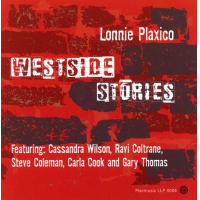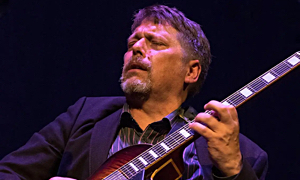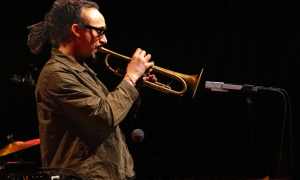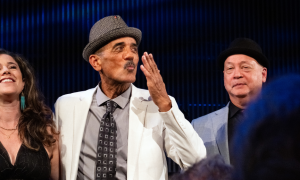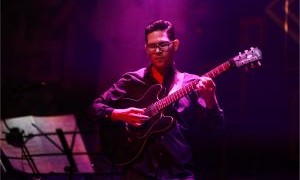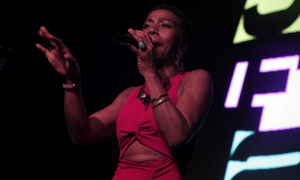Home » Jazz Articles » Live Review » Day 9 - Ottawa International Jazz Festival, June 30, 2006
Day 9 - Ottawa International Jazz Festival, June 30, 2006
Every year the Canadian Broadcasting Corporation's Galaxie station sponsors an opportunity unique to the TD Canada Trust Ottawa International Jazz Festival. Galaxie is a continuous music network that provides 45 music channels uninterrupted by commercials or talk. Their commitment to this program has cultivated something which makes the Ottawa Jazz Festival stand out as more than simply a festival that brings outstanding artists to the city to perform year after year, but also one that views the philosophy of nurturing aspiring young artists to be an important part of keeping jazz alive for years to come.
The Galaxie Jazz Clinic All Stars brings together a group of students, ranging in ages from 16 to 21, from across the country, through a somewhat complicated selection process, for a week-long intensive series of workshops overseen by jazz professionals, including some of the very artists who perform at the festival. The workshop also works to turn a group of musicians who at the beginning of the week may have never met before, but at the end of the week is truly a band. The week culminated in a performance on the festival's main stage and the award of two cash grants, to be applied to post-secondary education in a jazz stream.
The primary instructors at the workshop over the years have been two of Ottawa's most prominent and diversified artists- -bassist John Geggie and saxophonist Rob Frayne. At a workshop with guitarist Rez Abbasi, who performed the previous day at the Connoisseur Series, Geggie commented to the young players about just how remarkable it is that, after meeting a week ago, they are now truly a band.
At the close of the 5 pm performance Montreal drummer Marc Béland received the Galaxie Rising Stars Award for $2,000. Peterborough bassist Daniel Fortin was the recipient of the $1,000 bursary from Harvey Glatt, a local entrepreneur who, amongst his own many accomplishments, ran a successful record and audio equipment chain in the 1970s and started CHEZ 106, one of Ottawa's most successful FM stations for nearly 30 years.
This year's Connoisseur Series at the Library and Archives Canada theatre has been widely regarded as one of the best—if not the best—series in recent years. With nary a weak spot to be found, it was also a diverse mix, from the Indo fusion of Rez Abbasi and the incredible explorations of Sonny Fortune and Rashied Ali to the outstanding performances by Brad Mehldau's trio. The final show of the series featured Israeli bassist Avishai Cohen, who first leapt into the spotlight with pianist Chick Corea in the late 1990s, but recently has been focusing more exclusively on his own projects and label, RazDaz.
Cohen is a virtuosic player with a deep knowledge of the tradition, but in the interview that took place with CBC's Andy Sheppard before the show, he talked about how folk music—"people's music," as he put it—is a stronger source of inspiration. When asked about his broad musical influences and the way in which he blends them together, he saied "I never came to think this way, I just am this way," which dovetailed nicely with the sentiments of Rez Abbasi and Vijay Iyer at the previous two afternoon performances.
Cohen's set list was drawn primarily from his latest record, Continuo (RazDaz, 2006) and At Home (RazDaz, 2005), and brought together the same two musicians who are part of the core group on both discs—pianist Sam Barsh and drummer Mark Guiliana, who has his own record out on Cohen's label with his group Neernt, Locked in a Basement (RazDaz, 2006). Both are young players but not only show significant promise, but feel very simpatico with Cohen's personal cross-genre concept. Cohen, in fact, described the two of them as people who became friends first, then players in his group.
Andy Sheppard's description of Cohen's playing—"he surprises the bass"—is an apt one. While the material was an interesting mix of classical constructs, folkloric melodies and jazz harmony, and there were strong melodies throughout, the solos were what made this a strong closer to this year's Connoisseur Series. Barsh would often take his time developing his solos, building in intensity and dexterity. Swaying backward and forwards as he played, there were definitely some of the magical moments where Barsh made it "into the zone," lithe and lyrical. In some ways his overt melodism compares to the previous days' performance by EST's EsbjÃrn Svensson, but without the electronics (although he did have a small synthesizer that was not ultimately used).
Guiliana is a drummer who appears to be cut from similar cloth as Rez Abbasi's Danny Weiss. Loose, responsive and with an approach that veered towards backbeat but rarely went all the way there, he was in constant contact with Barsh and Cohen, pushing them while, at the same time reacting to where they were going. The subject of interaction and chemistry has been repeated throughout coverage of the festival, but in many ways it's been a remarkable year for the number of artists that have performed here who have demonstrated the kind of empathic connection that makes for the most inspired and exciting music.
Cohen demonstrated a number of unusual techniques, at one point not so much tapping the bass' neck with both hands as pulling off notes with each one. He's one of the most important bassists to emerge in recent years, and the performance demonstrated why. While he's constantly pushing himself in his solos to go to new places, he's not operating in a vacuum, maintaining constant eye contact with Barsh and Guiliana and absorbing where they are going to determine the direction of his own solo. It is, in fact, this give-and-take that made the trio in some ways comparable to EST. But while EST are unquestionably fine players, the interaction seems to weaker, with Svensson expecting Berglund and Ostrom to follow along rather than be equal participants in the conversation.
One of the most noticeable things about Cohen's playing is how it has matured so rapidly. When he first emerged with Corea, in some ways he was the bold, brash young player with things to prove. He may not be much older now, but his playing has reached a point where he doesn't need to prove a thing. Consequently, while he still burst into lightning-fast lines at time, he was equally attentive to the value of a single note, or a simple repeated phrase.
Cohen's writing masks tricky time changes and harmonic foundations with such elegant melodies that one really doesn't notice just how involved they are, although "One for Mark" was based around a choppy, irregular meter that featured some impressive (and humorous) stop/starts where it was clear just how much fun the trio was having. In brief conversation with Cohen he explained that this band has been touring a lot, across North America, Europe and elsewhere, and it shows. Sometimes a nervous energy that results in musical magic can occur when you put a group of players together for the first time; but equally, chemistry is something that develops best over time, and with so many artists having to spread their time amongst a variety of projects in order to keep working, it's great to see a group that's committed to a longer-term relationship.
One of the unfortunate realities of festival programming that the Ottawa International Jazz Festival has succumbed to only recently—last year, in fact, with the introduction of the 8 pm Improv Series—is that you simply can't see everything. And it was especially unfortunate that piano legend McCoy Tyner was put up against Norwegian trumpeter Nils Petter Molvaer. While Molvaer attractad a generally younger audience, the fact is that his music appeals to anyone with an open mind about the possibilities of jazz and the necessity of keeping it a living, breathing art form.
Tyner, while not enjoying the same youth appeal, is nevertheless an artist who interested young fans should see, if for no other reason (and there are many more) than for his stature as a member of saxophone icon John Coltrane's classic '60s quartet. For jazz to remain viable it has to respect where it came from while having the latitude to go to new and unexpected places. While both aspects were available to audiences last night, the sad fact is pthat eople had to make a choice.
Tyner was accompanied by an all-star band of younger players—tenor saxophonist Eric Alexander, altoist Donald Harrison, trombonist Steve Turré, trumpeter Wallace Roney, bassist Charnett Moffett and drummer Eric Gravatt. Most are leaders in their own right, but demonstrate varying degrees of linkage to the tradition and contemporary innovation. Roney is the most forward-thinking of them all, as recent albums including Mystikal (Highnote, 2005) demonstrated. Alexander is, perhaps, the most steadfastly traditional of them all. Harrison occupies territory somewhere in between, while Gravatt is making a recent comeback to music after more than two decades away.
Tyner's set leaned heavily on the innovations he created during his time with Coltrane and, since then, has continued to hone. Some artists remain evolutionary for the entire careers; in the case of Tyner the revolution occurrded in his youth, with the rest of his career being more evolutionary. It's a shame that those who chose to see Molvaer had to miss Tyner's set, especially since Tyner is not getting any younger and the opportunity may not present itselt to see him in Ottawa in the future.
Norwegian trumpeter Nils Petter Molvaer first emerged in the mid-1980s with Masqualero, a band co-led by bassist Arild Andersen and drummer Jon Christensen—two names familiar to fans of the ECM label. In addition to a Norwegian release, Molvaer participated on three albums by the group on ECM that took Miles Davis' second quintet as a starting point. But it was the release of Khmer (ECM, 1998)—his first album as a leader—that established him as more than a fine trumpeter, but a true musical innovator. Along with guitarist Eivind Aarset and keyboardist Bugge Wesseltoft, Molvaer spearheaded the Nu Jazz scene—an indefinable blend of ambient, electronica, world music sources and more with the improvisational spirit of jazz.
His performance last night, which closed out the second year of the festivals Improv Series at the National Arts Centre's Fourth Stage, brought together a veritable Nu Jazz super-group of artists who all are innovators and leaders in their own right—guitarist Eyvind Aarset, whose Connected (Jazzland, 2004) is the third in a series of groundbreaking records that dispense with any conventional definition of his instrument; sampler Jan Bang who has been involved with everyone from singer Sidsel Endersen to neoclassicist Ketil Bjornstad; turntablist Pål "DJ Strangefruit" Nyhus, who proves the turntable is a musical instrument; and drummer Rune Arnesen, who mixes powerful kit beats with loops and live processing. Still, it's not really fair to call them a super-group, because that implies a one-time event, whereas these musicians have been intersecting inside and outside of Molvaer's group for years.
Those who considered Wibutee an odd choice for the Improv Series would likely consider Molvaer's group in the same category, but they'd be mistaken on both counts. But despite Wibutee putting on a powerful performance, in Molvaer's case the language is much broader, the textures more diverse and the underlying philosophy so much deeper.
Opening in almost total darkness, sound developed slowly, amorphously, more texture than melody. For ten minutes the group layered sounds gradually, sometimes imperceptibly, until Arnesen's propulsive rhythm began to emerge. Perhaps one of the most interesting aspects of seeing Molvaer perform live is the opportunity to determine who is doing what, because there is so much processing going on that it's often impossible to tell when listening to the albums. Aarset is a completely unique antithesis to what most people conceive of as guitar playing. With a wide array of signal processors and an approach that almost completely avoids conventional rhythm playing or overt soloing, in his hands the guitar becomes an orchestra, evoking textures and colors rarely, if ever, heard on guitar.
Molvaer, too, processes his trumpet with an array of effects. There are times when his tone is in the same general space as the Jon Hassell, but he's evolved his own distinctive tonalities as well. Combining extended techniques on the horn with delays, pitch shifters, wah wah and more, he has, like Aarset, redefined the possibilities of his instrument to the point where truly anything is possible.
While the group would find their way to pulsating, at times techno-like, rhythms, they were just as quick to dissolve again into cinematic audioscapes where Molvaer was the sole provider of any kind of melody. Capable of rich lyricism, while Molvaer has left the conventional jazz world behind, its more expansive vernacular still informs his playing with respect to building more profound melodies. He may not be about what conventional jazz listeners consider the definition of artistry—dexterity, for example. But in charting his career it's clearly a case of "been there, done that," now transcending orthodoxy and instead aiming to create a distinctive musical universe where composition is a roadmap— where a rare framework of chord changes from Aarset or a melancholy and sparse melody from Molvaer create a context around which everything else can evolve.
For purists who feel that turntablists and samplers aren't musicians, Molvaer's performance might have been—certainly should have been—an eye-opener. Music is more than notes and rhythms. It's texture, it's color, it's translating the visual to the aural. The contributions of Bang and DJ Strangefruit to the music cannot be underestimated. For those used to conventional instruments, watching them find just the right sounds, loops and interesting vocal snippets was an education in the importance of being open-minded about music. They were also absolutely equal members when it came to the improvisational aspect of Molvaer's music, and equal partners in developing the unorthodox structure of his compositions. On the floating and poignant "Only These Things Count" from er, for example, Bang triggered a sample of singer Sidsel Endersen's harmony vocals to complement his and Molvaer's delivery of the main melody—also sung by Enderson on the record.
The 90-minute set consisted of two long extended medleys of material from a cross-section of Molvaer's discography, and a short piece in the middle. What was, perhaps, most remarkable about the show—that ranged from strong, danceable rhythms to more ethereal atmospherics where Molvaer's trumpet alone provided safe passage through the sometimes dense clusters of sound surrounding him.
And it was Molvaer's lone trumpet—this time pure and unprocessed—that closed the show on his brief encore. Unaccompanied, Molvaer proved that while his overall concept may be broader, more orchestral and more cinematic, at his core he's still capable of creating so much with so little. A beautiful way to end a performance that should have the Fourth Stage's capacity crowd spreading the word. And with Molvaer recently inking a deal through Thirsty Ear to get his post-ECM work released in the US—starting with the recently-released An American Compilation (Thirsty Ear, 2006)—hopefully his innovations, and those of the company he keeps, will reach the broader audience in North America that has eluded him to this point.
Once again an inspired choice from the Ottawa International Jazz Festival who, on its ninth day, closed out two series that provided some of this season's best, most diverse and intrepid music.
Visit Avishai Cohen, Nils Petter Molvaer and the TD Canada Trust Ottawa International Jazz Festival on the web.
Photo Credits
McCoy Tyner: John R. Fowler
All others: John Kelman
Tags
PREVIOUS / NEXT
Support All About Jazz
 All About Jazz has been a pillar of jazz since 1995, championing it as an art form and, more importantly, supporting the musicians who make it. Our enduring commitment has made "AAJ" one of the most culturally important websites of its kind, read by hundreds of thousands of fans, musicians and industry figures every month.
All About Jazz has been a pillar of jazz since 1995, championing it as an art form and, more importantly, supporting the musicians who make it. Our enduring commitment has made "AAJ" one of the most culturally important websites of its kind, read by hundreds of thousands of fans, musicians and industry figures every month.


